Thanks to our current Pandemic, all of the audio shows have been canceled, which makes it hard for me to hear new products, and put together systems for your edification. Luckily, our good friend Walter Liederman of Underwood HiFi (https://www.underwoodhifi.com/) came to my rescue suggesting a pairing of his LSA LSA-10 Signature Monitor speakers with a Peachtree Audio Nova 300 amplifier. While I had not had the opportunity to hear the LSA-10s and have limited experience with Peachtree, I have great confidence in Walter’s ear, and therefore jumped at the chance. Since the Nova 300 offers an increasingly rare feature of a phono input, I opted to include the VPI Player with the Grado Opus 3 Maplewood bodied cartridge in the review. Though I am sure that Walter would recommend the Core Power Tech audio cables I went with the Cardas Iridium/Clear cables for three reasons; 1. I had them on hand (in these times of isolation I wanted to keep shipping to a minimum), 2. I am eminently familiar with their sonic signature, and 3. I felt they would complement the system by introducing as little coloration as possible.
LSA LSA-10 Signature Monitors:

LSA (Living Sounds Audio) was founded in 2006 by a group of musicians and music lovers with the stated goal, “to offer beautiful sound in a beautiful package while avoiding the farthest reaches of the price spectrum.” Their approach to this goal is a rather old school one of properly matching quality components via extensive listening, in other words, they do it by ear.
5 years ago, Walter Liederman of Underwood Hifi bought the company with the goal of introducing a new upgraded line of state of the art Internet Direct speakers, which was realized last year to rave reviews. In 2019, Walter’s biggest line, PS Audio went factory direct, so to control his own future destiny Walter decided to expand to a full line of LSA products. These will include power amplifiers, DAC’s, music streamers, phono stages, integrated amps, turntables, headphones, and headphone amplifiers which will all be sold at Internet Direct prices with no dealer profits.
I would like to open with the observation that the LSA-10 Monitors not only present a strikingly beautiful profile, but their arced side shape makes them much less fussy during setup as sidewall reflections are minimized. The LSA-10 Signature monitor uses a custom LSA 1” silk dome tweeter with a compact neodymium XBL2 magnet structure and a shallow waveguide to better integrate with the woofer, a single black anodized LSA custom aluminum 6.5” XBL2 woofer, and a single rear-mounted 5” x 7” sub-bass radiator. The LSA-10 Signature uses a computer designed 4th order Linkwitz Riley acoustic crossover with an impedance of 12 ohms and a minimum of 9 ohms for super easy drivability.
XBL (Extreme BL [motor strength]) is a patented dual gap architecture technology used in LSA transducers to provide extremely high output, very wide bandwidth, and exceptionally low THD. By using aluminum drivers and formers as heatsinks they get additional cooling that allows for much longer throw translating into more output with lower bass frequency capability along with lower distortion.

Specifications:
Price: $2,495.00/pr
Manufacturer’s Website: https://thelsagroup.com/products/lsa-10-signature
Tweeter: Custom LSA 1” silk dome tweeter with a compact neodymium XBL2 magnet structure and shallow waveguide
Woofer: Black anodized LSA custom aluminum 6.5” XBL2 woofer
Radiator: Rear-mounted 5” x 7” sub-bass radiator
Crossover: Computer designed 4th order Linkwitz Riley acoustic crossover fine-tuned by ear
Impedance: 12 ohms
In-room frequency response: 38 Hz to 20 kHz +/-3dB.
Color: Satin finish chocolate brown veneer with magnetically attached grille.
Size: 13.5″ H x 14.25″ D x 8.0″ (baffle). Widest W dimension is 9.5″
Weight: 25 lbs ea
Shipping weight: 55 lbs for the pair
Peachtree Audio Nova 300:
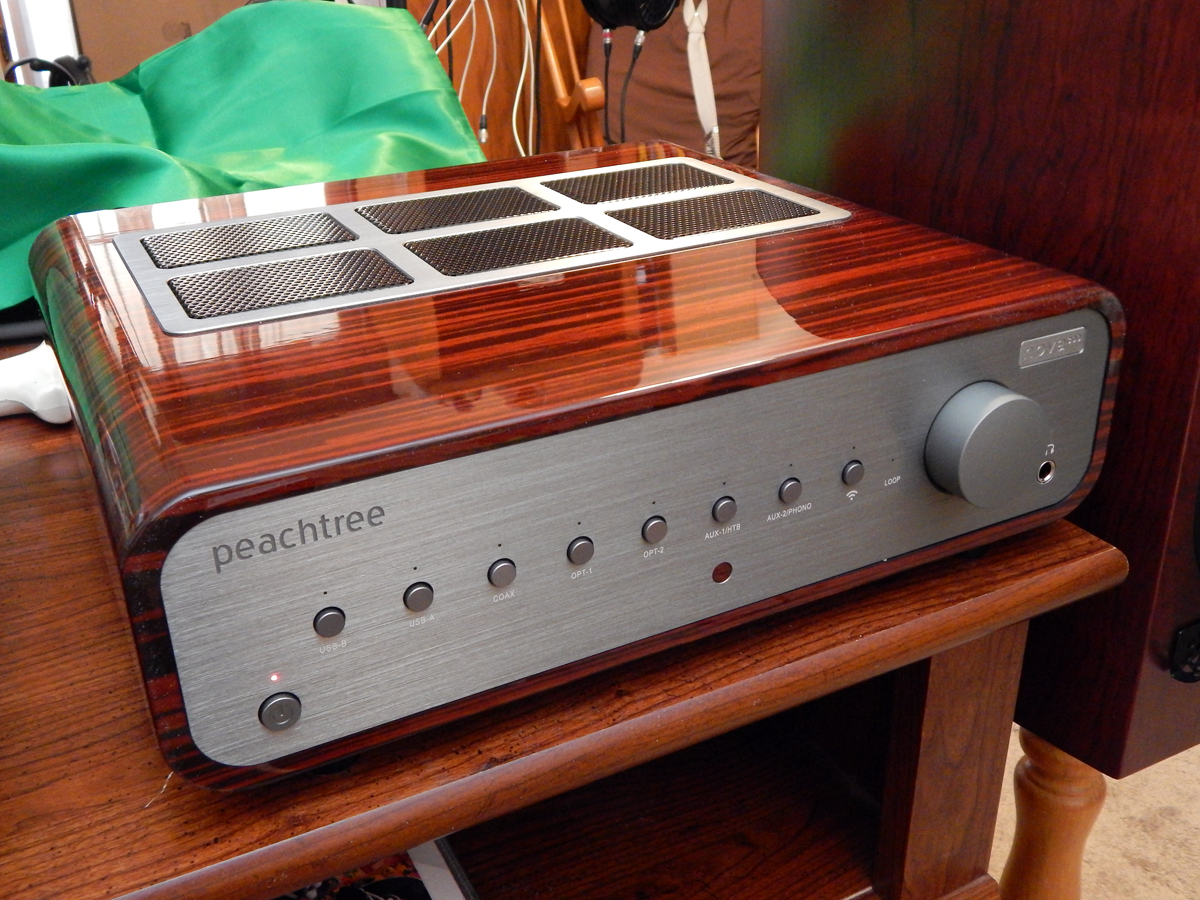
Founded in 2007 Peachtree Audio is a company dedicated to digital music with the understanding that the future was computer and streaming based media. The Peachtree Audio Nova 300 is an integrated amplifier with a built-in USB DAC. Its staggering list of special features are as follows:
- ESS Reference 9018K2M Sabre DAC
- 32-Bit/384kHz PCM and 5.6MHz DSD (double-DSD) compatibility
- New generation ICEPower amplification – 300 watts per channel @ 8Ω
450 watts per channel @ 4Ω - Extensive internal grounding
- Designed by a world-class engineering team
- Asynchronous USB, Coax and (2) Optical inputs
- Asynchronous iOS input for direct digital input from Apple Lightning devices – with exclusive Peachtree DyNEC (Dynamic-Noise Elimination Circuit) technology
- Phono (MM) input
- Home Theater Bypass
- Loop feature to add an external tube buffer, EQ, or other processor into the signal path
- Pre-Out for use as preamp/DAC or with subwoofer
- HIGH OUTPUT discrete headphone amplifier
- Available in Gloss Ebony Mocha and Piano Black
- Made in North America
My first impression pulling it out of the box was, wow it’s pretty. The Gloss Ebony Mocha wood chassis gives it a vintage high-end feel very reminiscent of my first integrated amplifier, with a touch of the ultra-modern in the smooth curves. The faceplate is very minimalist with a series of buttons each accompanied by a small LED for the inputs (USB-B, USB-A, COAX, OPT-1, OPT-2, AUX-1/HTB, AUX-2/PHONO, and Peachtree Wireless Input Module [optional, not installed in the review sample]), an additional LED for the LOOP OUTPUT/LOOP INPUT circuit, the Volume Control, ¼” TRS Headphone Output and the Power Button. The LED’s do double duty acting as Volume indicator. Due to the Nova 300’s relatively compact size, the back panel is fairly crowded. You have the Master Power switch, the AC Input and Fuse Holder, a port where the WiFi Antenna would be if the wireless streaming module were installed, IR repeater input, 12V Trigger output, a USB service port (Not intended for user use, it does provide 5V/500mA output for driving external devices), a USB-A input for use with iOS devices, a USB-B input with a switch to toggle between USB1.0 and USB2.0 (which requires downloadable Windows drivers), a Coax S/PDIF digital input, 2 Optical S/PDIF digital inputs, an Output /Input Loop (RCA), a Preamp output (RCA), 2 Auxiliary inputs (RCA), a Grounding post and 1 set of 5-Way binding posts for the Speaker output.
The Remote Control includes all of the front panel functions plus Mute, Dim (for the front panel LEDs, since the LEDs are fairly small, and only one is lit at a time normally, and the effect is subtle with multiple settings, I had to cycle it several times before I realized that it worked, going from dimmest to brightest is noticeable, but this might be different in a dark room), Loop, and my favorite function of the remote; Track Forward, Track Back, Pause, and Play, which worked with both Qobuz and JRiver.
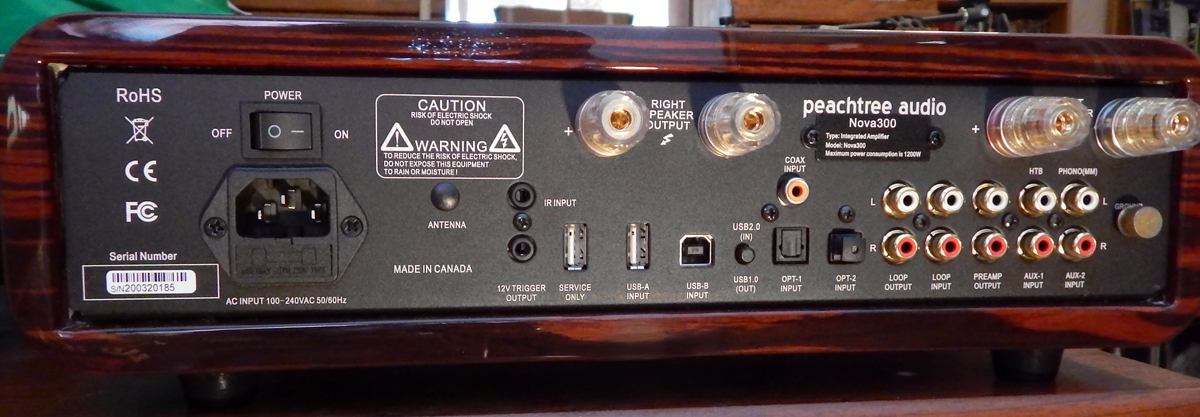
Specifications:
Price: $2,199.00
Manufacturer’s Website: https://www.peachtreeaudio.com/nova300
| SPEAKER OUTPUT | |
| Compatible Speakers | 2.5-16Ω |
| Output Power (WPC, 8Ω | 4Ω, <1% THD+N, AES17) | 300 | 450 |
| Dynamic Range (A-weighted) | 105dB |
| Damping Factor (1kHz, 8Ω) | >625 |
| Frequency Response (20 – 20kHz) | <+/-0.4dB |
| Inter-Modulation Distortion | >80dB below fundamental |
| Total Harmonic Distortion (AES17, 1kHz, 4Ω) | 0.005% |
| Channel Separation (1kHz, 8Ω) | >90dB |
| PREAMP OUTPUT | |
| Output Voltage (rms) | 3.8V |
| Output Impedance | 100Ω |
| Signal-to-Noise Ratio (Analog | Digital Source, un-weighted) | 105dB | 105dB |
| Channel Separation (1kHz) | >115dB |
| Frequency Response (Analog | Digital Source, 8Hz-20kHz) | <0.1dB | <0.5dB |
| Total Harmonic Distortion | 0.003% (2V rms, 1kHz, un-weighted) |
| HEADPHONE OUTPUT | |
| Output Power (32Ω, rms | peak) | 1200mW | 2770mW |
| Output Power (300Ω, rms | peak) | 330mW | 700mW |
| Output Power (600Ω, rms | peak) | 170mW | 350mW |
| Output Impedance | 1Ω |
| Signal-to-Noise Ratio (Analog | Digital Source, un-weighted) | 107dB | 106dB |
| Dynamic Range (Analog | Digital Source, un-weighted) | 107dB | 100dB |
| Channel Separation (1kHz) | >100dB at 1kHz |
| Frequency Response (Digital source, 8Hz-20kHz) | <0.5dB |
| Frequency Response (Analog source, 8Hz-100kHz) | <0.1dB |
| Total Harmonic Distortion | 0.003% (2V rms, 1kHz, un-weighted) |
| USB-B Input | |
| Formats | PCM and DSD |
| PCM Sampling Rate and DSD Frequency Rate |
16-32 Bit, 44.1-384kHz PCM 2.8224-5.6448MHz DSD |
| COAX and OPT Inputs | |
| Formats | 16-24 Bit, 44.1-192kHz PCM |
| AUX Inputs | |
| Maximum Voltage (rms | peak-to-peak) | 3.5V | 10V |
| Impedance | 100kΩ |
| PHONO Input | |
| Maximum Input Voltage (rms) | 120mV |
| Impedance | 47kΩ |
| RIAA EQ | No rumble filter used |
| LOOP Output and Input | |
| Maximum Voltage (rms | peak-to-peak) | 3.5V | 10V |
| Impedance (input | output) | 100kΩ | 100Ω |
| AC Power | |
| AC Input | 100-240VAC, 50/60Hz |
| Maximum Power Consumption | 1200W |
| On Mode (Idle) Power Consumption | 32W |
| Standby Mode Power Consumption | <0.5W |
| Fuse |
100-120VAC: 8A/250V Medium Acting 220-240VAC: 4A/250V Medium Acting |
| Physical | |
| Height (including feet) | 4.37 inches | 111 mm |
| Width | 14.02 inches | 356 mm |
| Depth (including volume knob and speaker binding posts) | 14.25 inches | 361.95 mm |
| Weight (shipping weight) | 17 lbs (21 lbs) | 7.7 kg (9.5 kg) |
| Warranty | |
| Parts and Labor |
Two years Three years if registered online |
Cardas Iridium/Clear Cables:
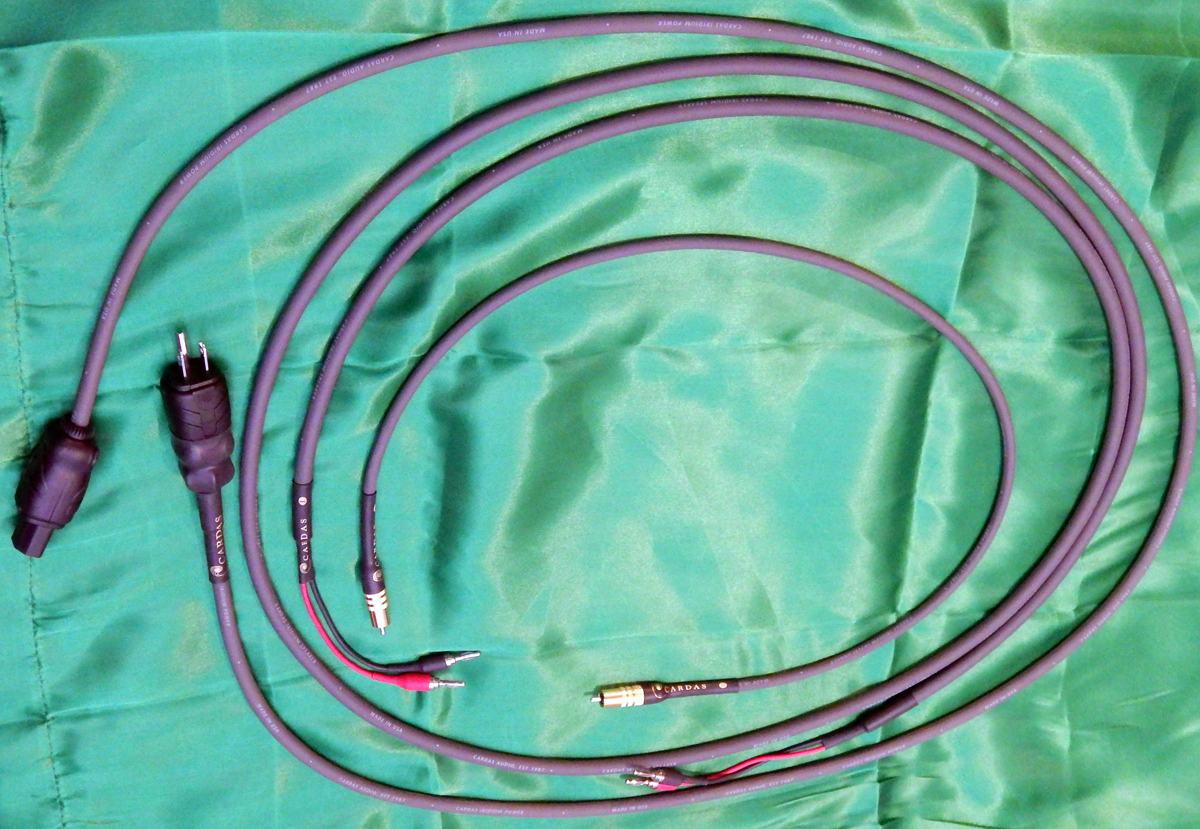
Once again I have chosen Cardas cables to enhance the system by doing the least possible harm to the sound. If one takes an unbiased view of music reproduction, for acoustical music every link in the chain adds some form of distortion, from the microphones and their placement, through the recording process, to the playback device (whether it be analog or digital) to the amplification to the speakers to the room which the playback occurs, including all of the cable involved in that chain. Cardas has always been my favorite cable line since I first discovered them in the late ‘80s because they do the least amount of perceivable damage to that process.
George Cardas’ use of the Fibonacci Sequence to develop his “Golden Ratio” of non-harmonic wire strands for what he calls Constant Q Stranding was inspired. To quote the Cardas home page:
“a high-end audio cable must balance resistance, capacitance, inductance, conductance, velocity of propagation, RF radiation and absorption, mechanical resonance, strand interaction, high filtering, reflections, electrical resonance, dissipation factors, envelope delay, phase distortion, harmonic distortion, structural return loss, corrosion, cross-talk, bridge-tap and the interaction of these and a hundred other things.”
A goal Cardas handily achieves, creating a cable with unmatched in my experience, linear bandwidth, phase linearity, phase coherency, tonal balance, and timbre.
Cardas Iridium cable is their entry-level design incorporating, Golden Ratio, Constant Q, Cross-Field, pure copper Litz, conductor technology, meaning that it provides that unique Cardas performance at a price that fits within the confines a medium budget audiophile system.
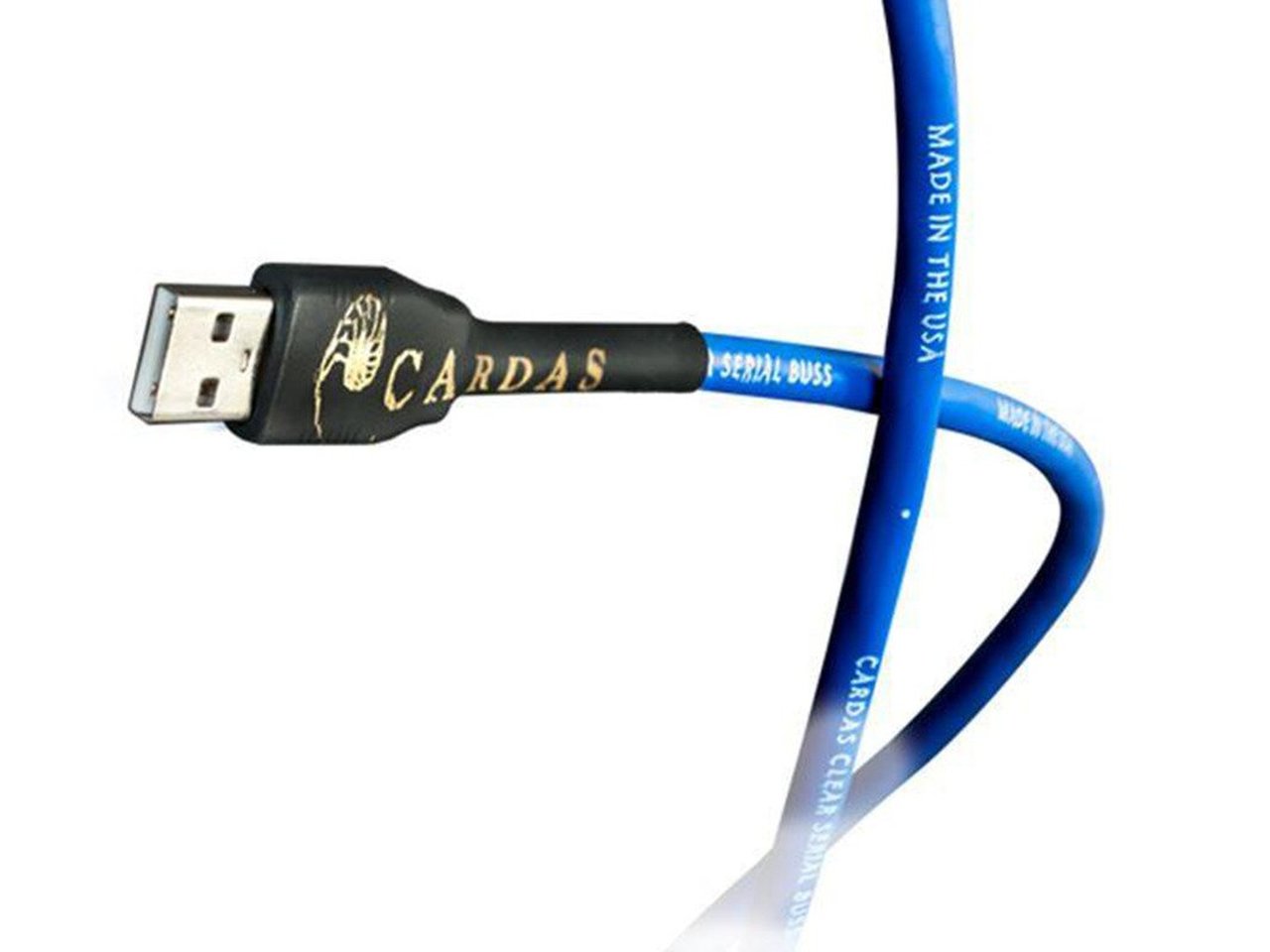
Manufacturer’s Website: http://www.cardas.com/cables.php
The cables used in this review were:
- two 2-meter Cardas Iridium Power Cables ($300 ea.)
Technical Specifications:
Construction
Shielded, with two Cardas 11.5 AWG Crossfield Conductors, PFA tape dielectric, toroidal filter, Cardas 3455R Power Connectors.
Termination Options:
Iridium Power comes standard with Cardas 3455R wall plugs & 15 amp IEC connectors, featuring copper blades plated with rhodium over silver. All standard international wall plugs are also available, as are 20 amp IEC connectors.
- one 1-meter pairs Cardas Iridium Single-Ended (RCA) Interconnects($250 ea.)
Technical Specifications:
Construction:
.300″ O.D., Cardas copper, PFA & Carbon Impregnated tape dielectric, 4 x 24.5 AWG conductors, Golden section, Crossfield, litz, spiral shield, TPR jacket.
Termination Options:
Iridium is terminated with Cardas GRMO RCA plugs, or Neutrik XLRs.
- one 3-meter pair Cardas Iridium Speaker Cables fitted with Banana connectors ($500)
Technical Specifications:
Construction
.345″ O.D., Cardas copper, PFA dielectric, 2 x 11.5 AWG conductors, Golden section, twin axial construction, litz, neoprene jacket.
Termination Options:
Cardas milled spades, Cardas CABE banana.
- one 2-meter Cardas Clear Serial Bus Rev 1USB Cable ($200)
VPI Player:
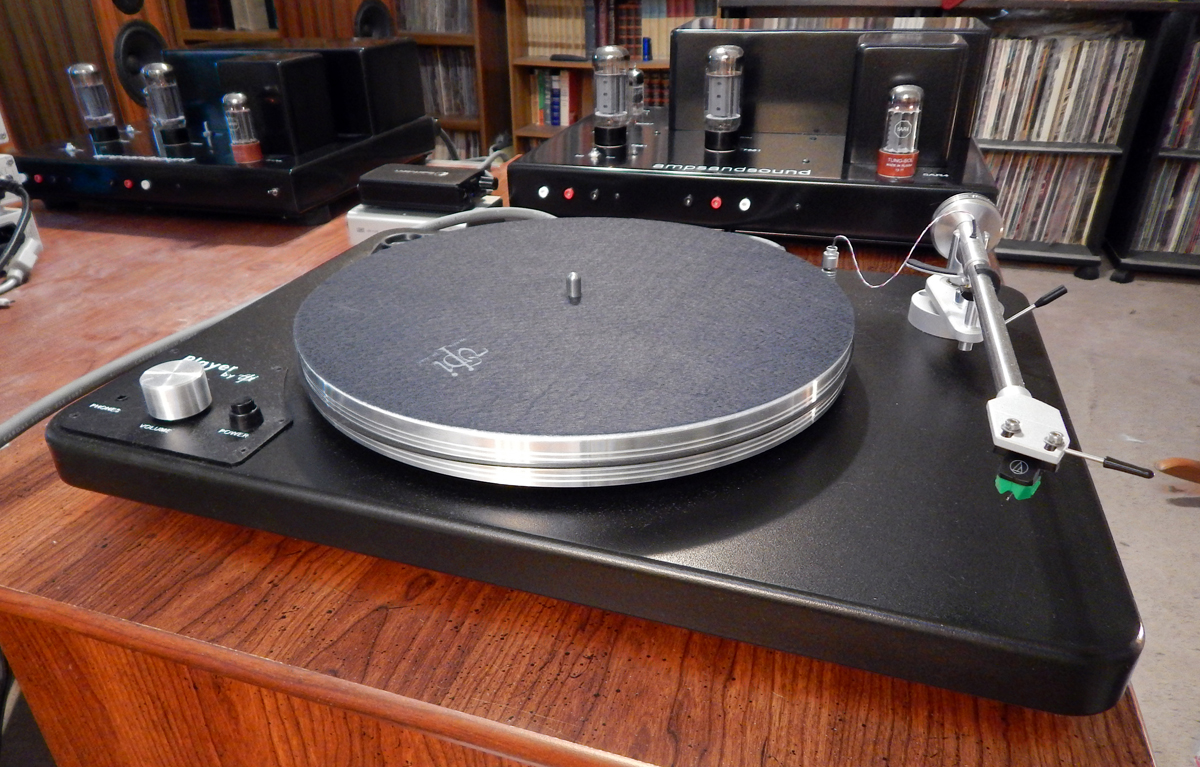
VPI, like Cardas, is another one of those companies that I have had a love affair with since the late ‘80s, and thanks to the Covid-19 crisis I have had the VPI Player to play with for several months, which has prompted more than one review in addition to my original review of two years ago: https://www.headphone.guru/vpi-player-turntable-with-built-in-phono-preamp-headphone-amplifier-analog-sensations/
The extensive list of features for the VPI Player is as follows:
- Gimbal Tonearm
- AT-VM95E Cartridge
- Built-in Phonostage
- Built-in Headphone Amp
- Ready to play out of the box
- Made in the USA
The turntable used in this review had a handsome black plinth which matched really well with the Nova 300 amplifier as black works with most anything. It came prefitted with the Audio-Technica AT-VM95E cartridge which is a wonderful budget cartridge in itself, but I swapped it out for the Grado Opus3 Maple Bodied Phono Cartridge in order to review the cartridge, and as it was preferable in sound, I used it also for this review.
Price: $1,600
Manufacturer’s Website: https://www.vpiindustries.com/player
Specifications:
| Chassis Composition: | Vinyl Wrapped MDF |
| Platter Type & Size: | 11.5″ Aluminum, 7 lbs |
| Tonearm Included: | Player Tonearm |
| Motor RPM: | 300 RPM |
| Motor Pulley Accuracy: | +/- .0005″ |
| Wow and Flutter: | .1% |
| Average RMS Distortion: | .36% |
| Footprint: | 16″ x 11″ |
| Overall Size: | 19″ x 14″ x 6″ |
| Total Weight: | 12.9lbs |
Grado Opus3 Maple Bodied Phono Cartridge:
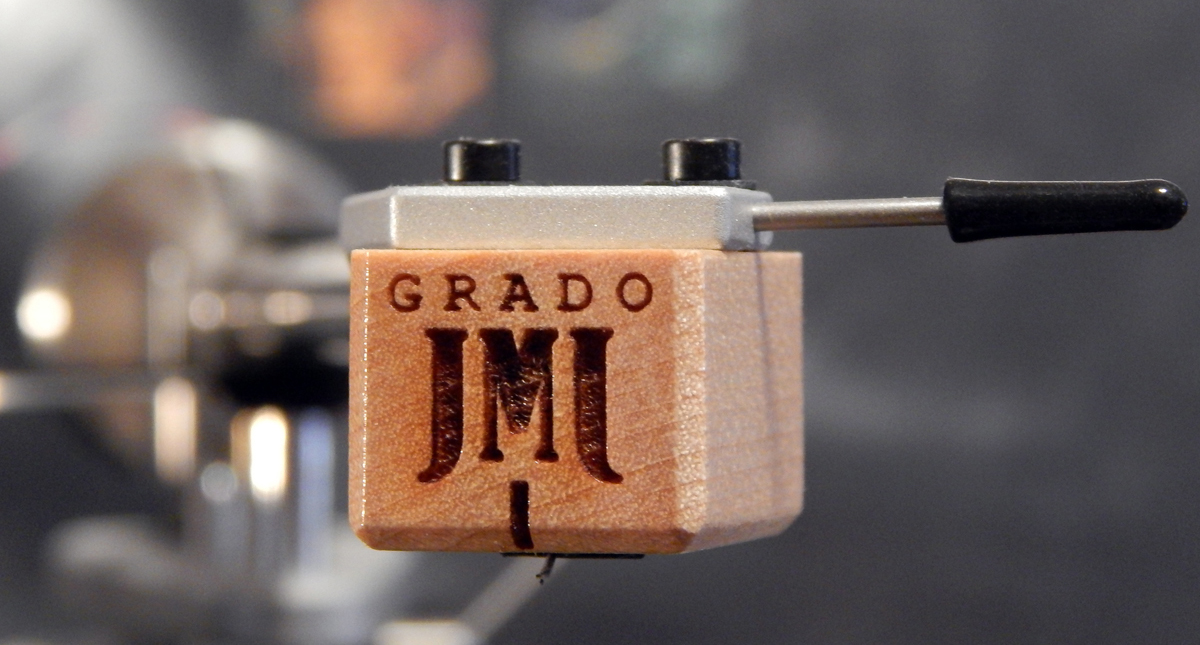
The Grado Opus3 Maple Bodied Phono Cartridge is their first cartridge to feature a maple wood body and was specifically intended to offer a cost-effective wooden cartridge while taking advantage of the techniques and processes used in the higher-end models in order to bring their entry-level and mid-range phono cartridges closer together, creating a richer and more amalgamated line, allowing the consumer easier access to incremental upgrades in their analog audio systems.
The Opus3 is also the first cartridge to apply the breakthroughs gained in designing their high-end cartridges to a budget cartridge, as well as being the first designed with the Timbre Series in mind.
The housing of the Opus3 is a new shape but still keeps the wood working in tandem with the cartridge inside. Maple was chosen for the housing after years of working with maple for their Heritage and Statement Series headphone which they found to provide a “vibrant and luscious sound, while staying consistent and clear.” Furthermore, Grado employs a variation of thermal aging processes to better dampen and control the resonant frequencies.
Grado has a long history of making world-class moving iron cartridges and the Opus 3 delineates the newest benchmark in that tradition. In their zeal to produce a state of the art product Grado has combined newly developed coil winding techniques with decades-old disciplines, and a new two-step shielding process brings not only exact unison between the four coils but an unobstructed path for a cleaner signal, greatly reducing mechanical noise.
Hand-built in Brooklyn the Grado Opus3 is precisely hand tipped with a diamond, and fine-tuned for use with entry-level turntables up to world-class mega-buck systems.
Price: $275
Manufacturer’s Website: https://www.4ourears.net/opus3
Specifications:
Body: Maple Wood
- Cantilever: Aluminum / Elliptical Diamond
- Output:
High 4.0mV @5 CMV (45)
Low 1.0mV @5 CMV (45) - Inductance:
High Output 55mH
Low Output 6mH - Resistance:
High Output 660 ohms
Low Output 70 ohms
- Input Load: 10k-47k ohms
- Cartridge Weight: 8 grams
- Tracking Force: 1.6-1.9 grams
- Compliance: 20μm/mN
- Channel Separation: Average 30db – 10-30k Hz
- Controlled Frequency Response: 10-60 kHz
The Listening Sessions:
A word of warning, this is not a system to judge on first glance. My experience with the first few days of burn-in using my Qobuz playlist was the sound was a bit bright and thin, but as the first hundred or so hours passed, the sound improved dramatically, so I continued the burn-in for at least another hundred hours and continued burn-in while writing the product descriptions above. On top of that, I have kept the amplifier powered up 24/7 (it often takes several days for solid-state amplifiers to reach operating temperature).
Not surprisingly due to the rear-facing passive radiator, the LSA-10 Signatures preferred the live end of the room, wanting a wall to reflect off. I settled for toeing the speakers outward slightly to reduce waveform cancellation in my small listening room while still affording me on-axis listening by repositioning my chair. It appears that the LSA-10 Signatures were voiced with the grills on as this was sonically superior to with them off, which did surprise me as they are metal without cloth so I really didn’t expect much change.
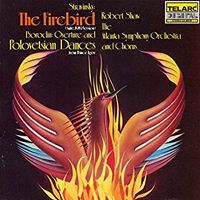
Opening with Robert Shaw and the Atlanta Symphony Orchestra’s rendition of “The Firebird Suite” (“Stravinsky: The Firebird; Borodin: Music from Prince Igor” – 16-bit/44.1kHz) I found the soundstage to be bright outdoor amphitheater with excellent depth and solid imaging. The contrabass cellos and tubas had a reverberant presence with great depth and resonance. The tonal balance was neutral to slightly bright with good bass extension and excellent dynamics.

Returning to Qobuz I selected “Jump Rope Gazers” (24-bit/44.1kHz) by The Beths. This was definitely an in-studio presentation with the vocals on “Dying to Believe” forward and intimate and the guitar up front while the drums and bass played in the background.

Sensing that this combo was ripe for live music I put on Blue Oyster Cult’s “E.T.I. (Extra Terrestrial Intelligence)” from their “Extraterrestrial Live” Album and it was like being on the edge of the stage at an outdoor concert with blistering guitar and thumping percussion.
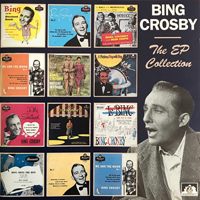
Before I switched over to vinyl, I thought I should run some vocals through the system so I put on “White Christmas” from the incomparable Bing Crosby (“The EP Collection” – 16-bit/44.1kHz) and was not disappointed. The soundstage was large nightclub about 10’ from the stage, with Bing up front and the orchestra and chorus behind and like everything so far, crisp and dynamic.
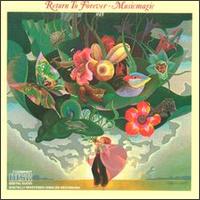
I began my analog session with Return To Forever’s “Music Magic” and immediately the musicality of the system kicked up several notches. It was definitely like having the band in the room while Chick Corea and Stanley Clarke jammed to Gerry Brown’s multilayered drumming complemented by a handful of world-class horn players and Gayle Moran on the B3. Once again I was reminded of why I am such an analog fan, this pushed budget high-end into true audiophile territory. The sound was realistic and the soundstage palpable, intimate yet spacious.

I followed this up with what is possibly my favorite album “No More Changes” by Nicky Hopkins (never released digitally). Notable was the fact that I could tell that he used different pianos for different tracks. The Grand Piano for “The Lady Sleeps” was elegant, regal and delicate while the upright piano for “Refugee Blues” and “Mornin’ I’ll Be Movin’ On” was rich and spritely and the grand piano for “Last Night’s Changes” and “Lady It’s Time To Go” was full and robust.
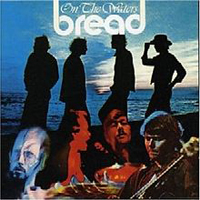
This review wouldn’t be complete without a test of the headphone amp so for this test I used my MrSpeakers (Dan Clark Audio) ETHER2 Orthodynamic Headphones and cued up “Make It With You” by Bread from their “On The Waters” album (24-bit/192kHz) and was favorably impressed by the sound, solid bottom end, smooth highs and plenty of power along with a decent soundstage.
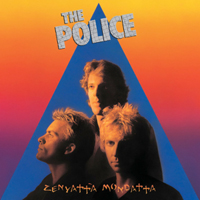
This was further affirmed by The Police’s “Man In A Suitcase” (“Zenyatta Mondatta” – DSD) which required a boost in volume due to the gain differences. While I wouldn’t buy the Nova 300 solely on its merits as a DAC/Headphone Amplifier, it performs those functions admirably especially given the retail cost of the overall system.
Now for the quirks, DSD is usually recorded at a lower mean volume than PCM but the Nova 300 seems to kick this difference up a notch (probably an aspect of the Sabre DAC chip). While the Nova 300 appears to have plenty of headroom, I did run it at full volume for a good deal of my tests especially with vinyl and DSD, but this does appear to be a gain issue rather than a power issue as no perceivable clipping was incurred. While this is not necessarily a bad thing, most receivers and integrated amps have too much gain reaching full output at half volume (hence the cause of the majority of speaker damage), it is something to be aware of.
The Conclusions:
This was an amazing system for the price ($8,119 in total, $5,994 for digital only, though Underwood HiFi offers a special package deal of the LSA LSA-10 Signature Monitors, the Peachtree Nova 300, a Bluesound Node2i streamer, a pair of the $450 Core Power Defiant Gold speaker cables, a $400 Core Power Valiant Gold series power cord and a $250 Core Power Conduit Gold coaxial digital cable for $3,999 delivered) that shows you can achieve true audiophile sound quality on a budget. While the addition of a subwoofer would add a little impact and rumble for theater applications, bass was never lacking and lovers of live music, classical, or acoustic music will appreciate the sparkle and dynamics as well as the large soundstage. I will point out that the system falls out on the brighter midrange heavy side like most audiophile systems, though never offensively so. Cymbals shimmered rather than sizzled and analog was spectacular.
On the other hand, I do believe that the LSA-10 Signature Monitors would scale up well with a tube amp, which of course is something the pre-amp outs of the Nova 300 allows for. Also, the Nova 300 has other capabilities that I am not set up to take advantage of such as the Home Theatre Bypass. Though at one time I had a $20,000 home theater system, it was buggy and unreliable and in the long run, I found that I was more than satisfied with a two-channel system for home theater.
All in all, as intended, this is a great entry-level to midrange audiophile system for someone who wants to step up their game from personal audio or home theater to really appreciate and enjoy the wonders of two-channel loudspeaker listening. Highly recommended.

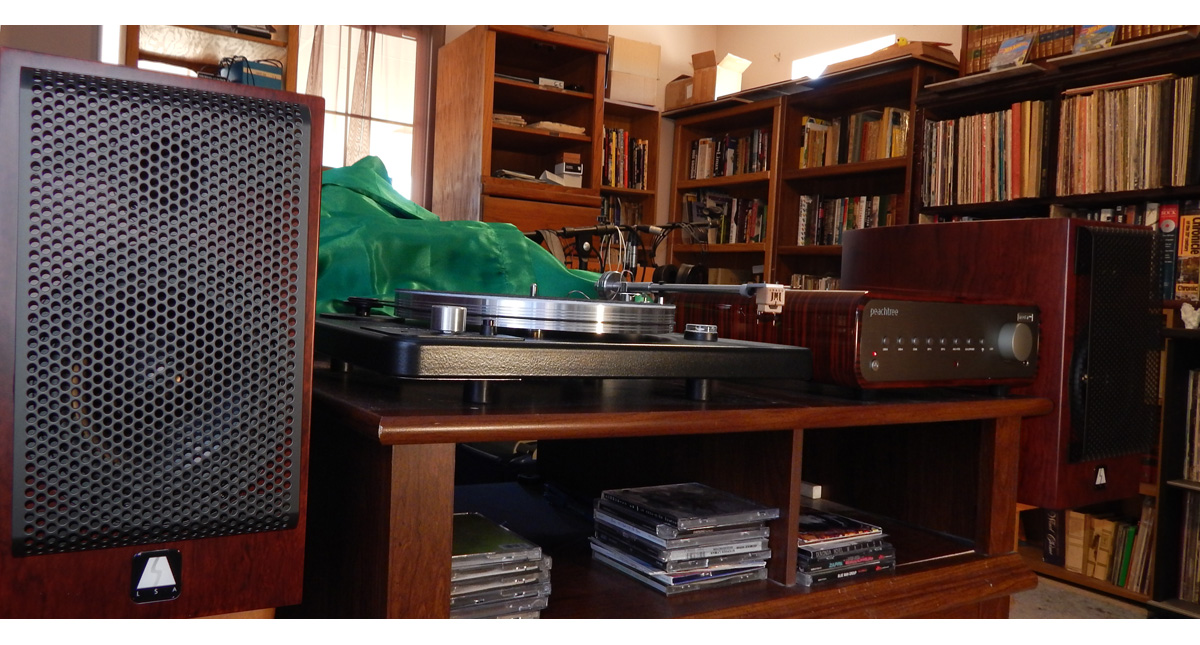






Leave a Reply
Want to join discussion?
Feel free to contribute!